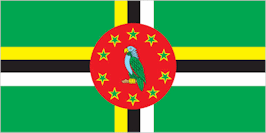Dominica - Government
 Independence did little to solve problems stemming from centuries of economic underdevelopment, and in mid-1979, political discontent led to the formation of an interim government. It was replaced after the 1980 elections by a government led by the Dominica Freedom Party under Prime Minister Eugenia Charles, the Caribbean's first female prime minister.
Independence did little to solve problems stemming from centuries of economic underdevelopment, and in mid-1979, political discontent led to the formation of an interim government. It was replaced after the 1980 elections by a government led by the Dominica Freedom Party under Prime Minister Eugenia Charles, the Caribbean's first female prime minister.
Dominica has a Westminster-style parliamentary government, and there are two major political parties--the Dominica Labour Party (the majority party), and the Dominica United Workers Party. The Dominica Freedom Party has lost its party base and is no longer a factor in elections. A president and prime minister make up the executive branch.
Nominated by the prime minister in consultation with the leader of the opposition party, the president is elected for a 5-year term by the parliament. The president appoints as prime minister the leader of the majority party in the parliament and also appoints, on the prime minister's recommendation, members of the parliament from the ruling party as cabinet ministers. The prime minister and cabinet are responsible to the parliament and can be removed on a no-confidence vote.
The unicameral parliament, called the House of Assembly, is composed of 21 regional representatives and nine senators. The regional representatives are elected by universal suffrage and, in turn, decide whether senators are to be elected or appointed. If appointed, five are chosen by the president with the advice of the prime minister and four with the advice of the opposition leader. If elected, it is by vote of the regional representatives. Elections for representatives and senators must be held no later than 5 years after the first meeting of parliament, although the prime minister can call elections any time.
The movement of the ceremonial mace to the lower position on its stand in the House chamber indicates that the House is sitting in committee, usually to discuss details of a bill before returning to a plenary session for a vote. Decisions are by simple majority vote, except on selected matters, such as constitutional amendments and the declaration of a state of emergency, when a two-thirds majority is required.
The Constitution allows for any citizen of the country, eighteen years of age and over, who is literate and not bankrupt, to organize and take part in political activity. The Constitution does not recognize political parties, nor is their formation required for participating in elections. Candidates may, therefore, run for election either associate with a party or as independents.
Dominica's legal system is based on English common law. There are three magistrate's courts, with appeals made to the Eastern Caribbean Court of Appeal and, ultimately, to the Privy Council in London. Dominica has a multilevel judicial system commencing with the Magistrate's Court, which is the first level of recourse for violators of the country's laws. The government-employed magistrate makes decisions at this level without the benefit of a jury. At the next level, a judge, assisted by ajury, presides over civil and criminal cases. Jurors are selected from the list of registered voters and, unless excused by the court, are obliged to serve when called. Appeals may be made to the Eastern Caribbean States Supreme Court, which consists of the Court of Appeal and the High Court. A panel of judges is appointed to hear appeals, and these sittings take place on the island. The court of last resort for Dominicans is the Judicial Committee of the Privy Council in London, where decisions of the Eastern Caribbean States Supreme Court may be reviewed for final ruling.
Councils elected by universal suffrage govern most towns. Supported largely by property taxation, the councils are responsible for the regulation of markets and sanitation and the maintenance of secondary roads and other municipal amenities. The island is also divided into 10 parishes, whose governance is unrelated to the town governments.
Supporting this government structure is a civil service of about 2,500 persons. In the past, jobs in the civil service were much sought after because of the employment security and status that they offered. Because of the expansion of the commercial private sector and nongovernmental organizations since the early 1970s, more attractive conditions of work in the private sector, including salaries, training, and travel, have encouraged a shift of top- and middle-level professionals away from the public sector. In the late 1980s, major adjustments in the size and structure of the civil service were anticipated as part of the government's program of structural adjustment.
|
NEWSLETTER
|
| Join the GlobalSecurity.org mailing list |
|
|
|

